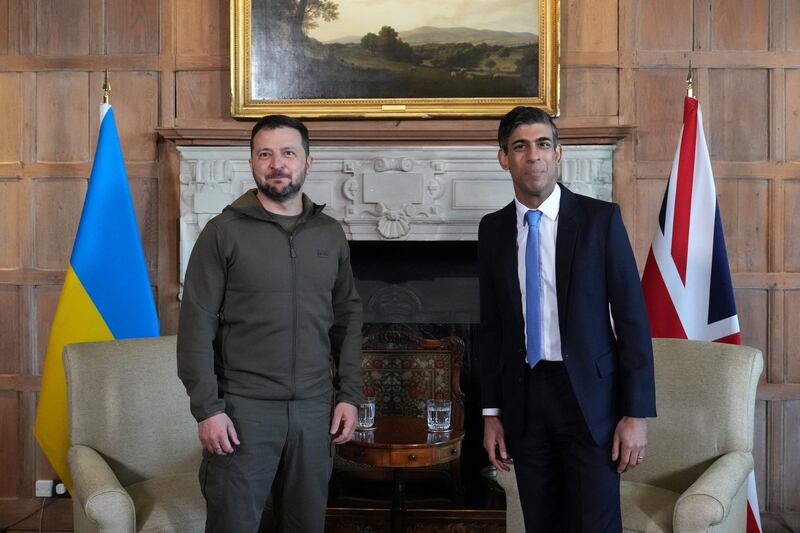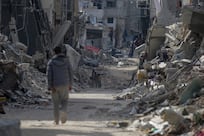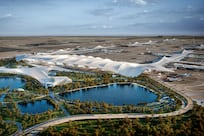A three-day flying visit to Europe’s major powers by Ukraine’s charismatic President Volodymyr Zelenskyy has secured a potent arsenal of tanks, missiles and artillery.
The latest leg on Monday led UK Prime Minister Rishi Sunak to promise more air defence missiles and hundreds of “new long-range attack drones with a range of over 200km”. This is in addition to the £2.3bn military support already given that includes a squadron of 14 Challenger 2 tanks, alongside the training of 15,000 Ukrainian troops in Britain.
France a day earlier promised dozens more of its AMX-10RC tank-destroying armoured vehicles, modern anti-aircraft missiles and did not dismiss his request for combat aircraft.
Germany announced a new $3 billion package of advanced Iris-T air defence systems, howitzers, artillery ammunition, Leopard 1 tanks and Marder infantry fighting vehicles.
It is likely that during his last visit to Britain in February, Mr Zelenskyy persuaded Mr Sunak to agree to the risky decision to supply long-range Storm Shadow cruise missiles to Ukraine.
It was only last week that Britain announced Kyiv was not only getting the missiles but already had them, hinting that technicians had already integrated the weapons on to Ukraine jets.
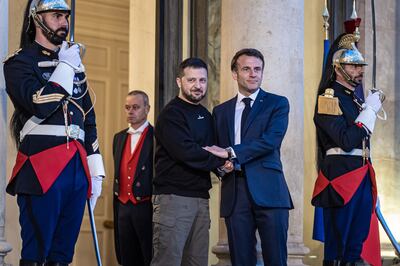
Analysts believe this was a key strategic moment, allowing Ukraine to strike well behind enemy lines.
“Russia has very little amounts of any decent kit left and cutting off their logistics hubs and command hubs, which is what these weapons are brilliant at, will prove crucial,” said former military commander Hamish de Breton Gordon.
Having the missiles in theatre ahead of the announcement also gave Russia little opportunity to move its command bunkers and kit beyond their 300km reach.
Mr Zelenskyy very clearly signalled his motivation for the trip. “Ties with Europe are getting stronger, and the pressure on Russia is growing,” he tweeted from Paris on Sunday. “With each visit Ukraine’s defence and offensive capabilities are expanding.”
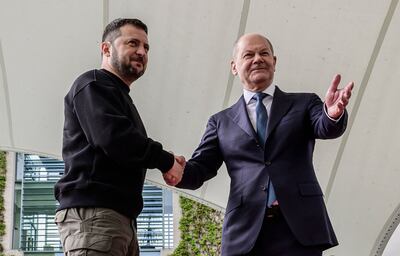
Ukraine is close to the launch of a counter-offensive, and the three days of visits suggest that Mr Zelenskyy knows he will be too busy in the coming months to leave the warfare nerve-centre in Kyiv.
The challenge is that while he has an army of 40,000 newly trained soldiers fielding arms more advanced than their Russian foes, the nature of modern combat is also highly destructive.
Ukraine will inevitably burn through its ammunition and armour as it seeks to penetrate Russia’s deep defensive lines.
There is an early suggestion that the work in securing a modern army will be rewarded. Ukraine's forces have in the past few days pushed back the Russians from ground flanking the long-besieged town of Bakhmut. They now threaten to encircle the attackers in the city, in a pincer reminiscent of how the Soviets trapped the German army in Stalingrad in 1943.
Two Russian commanders have already been killed and morale on the front line is reportedly very low, although yet to be properly tested by the sight of former Nato tanks in the combat zone.
There is a possibility that the modern army that Mr Zelenskyy has brought to bear on Russia may well provide too formidable, generating a broad collapse of the front.
The Ukrainians and others are understandably underplaying that possibility to manage expectations. They have also suffered at least one setback, with Russia successfully attacking two major arms dumps.
What is clear is that the Ukrainian President has in just over a year turned a largely Soviet-era force — reflected in both its equipment and its unimaginative tactical thinking — into arguably the most adept and effective fighting force in the world.
Mr Zelenskyy’s ability to get himself into the same room as his political counterparts has played a key part in that.
“Sunak, Macron and Schultz can't appear on a stage with Zelenskyy and not cough up the goods,” said Mr de Bretton Gordon. “It's brilliant statecraft by the Ukraine leader. But Europe’s politicians also understand that if Ukraine doesn't prevail, then quite frankly the world in the next 10 years is going to be a dreadful and dangerous place.”
Advocate for arms
The armaments diplomacy practised by Mr Zelenskyy could prove vital in supplying his country with the tools to defeat the Russian invasion. He knows doorstepping European leaders will not leave him empty-handed and his form of diplomacy is one of the most potent weapons in Ukraine’s arsenal.
And European leaders know Mr Zelenskyy’s value to them. It is not only his high-net worth as a global leader that had Luftwaffe Typhoon fighter jets escort his Airbus during the tour and Rome shutting its airspace for his arrival in Italy. It is the sprinkling of political gold dust that he brings to receptive leaders, such is his popularity.
Witness Mr Sunak welcoming him to Chequers with a smothering man-hug, or Mr Scholz firm handgrip and long photo opportunity in Berlin. Or indeed Mr Macron's double-handed handshaking and constant back-slapping at the Elysee Palace.
“I need ammo, not a ride,” he defiantly told the Americans on being offered a flight out of Kyiv in February last year. His demand for supplies has not stopped since.
The actor-turned-politician has a personality toolkit from which he can draw charm, persuasion and cudgelling to get his way, demonstrated by getting the West to part with its precious advanced tanks earlier this year.
